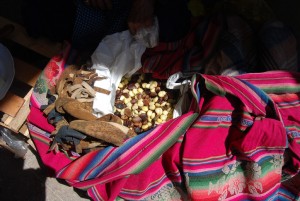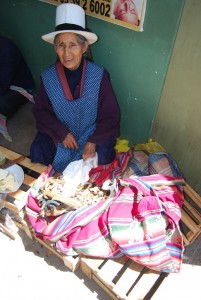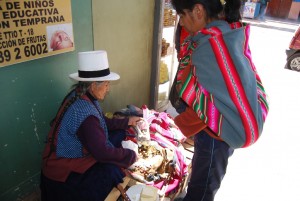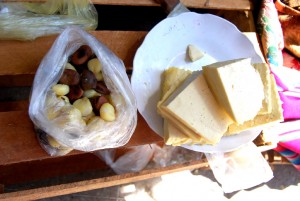Simplicity, Corn and Beans (Mote and Puspo)

One kind of food is that which is enshrined in the elaborate, while another seems basic and simple. Cuisines have both. Not infrequently the one is festive while the other accompanies the everyday. In Cuzco, at the market’s door we find the daily, wrapped in colorful cloth: puspo y mote, that is broad beans and hominy.
This combination, simple and yet complex (even if not elaborate) is widely consumed in the city of Cuzco. It is an emblematic appetizer that opens the appetite for what is to come. But if it is eaten in the city, it is even more consumed in the countryside where this bringing together of corn and legumes becomes a staple that seems as American as the land itself.
Though corn has deep roots in the Inca world, fava beans, broad beans do not. Called vicia fava, they are different from the phaseolus found in the New World and widely cultivated in Inca Peru. Called habas in Spanish, the broad beans were a staple of the Mediterranean and came to Peru with the Spanish, but now they seem as native as the terraces clinging to mountainsides on which so much produce is grown.
Whether they replaced an indigenous bean in this combination we do not know. Nevertheless, they fit into an indigenous form of preparation that was described by the important writer Garlilaso Inca de la Vega shortly after the Spanish invasion. He writes about the grains of corn.
Cómenlo en lugar de pan, tostado o cocido en agua simple. ([The Incas] eat it in place of bread, toasted or cooked simply in water.) (p 74)

The toasted grains of corn are called cancha, even though Garcilaso insists it should be camcha. The boiled grains of corn, on the other hand, are called, according to Garcilaso, musti. He writes that the Spanish pronounce this as mote.
The broad beans are dried and then toasted before being boiled. They are called phuspu in Cuzco Quechua and in its Spanish. Thus they combine both of the forms of preparing corn described by Garcilaso, while more importantly, in their presentation as food they white corn and the brown broad beans build an Andean dualism following a cultural preference for dual contrast that goes very deep into people’s lives even centuries after the Inca.

But there is another reason for the two together. They are more nourishing this way. People find they contrast in flavor delightful–the mildness of the corn against the almost meat-like depth of the haba, but they also like the carbohydrates and minerals the two bring together. They are filling and calm hunger while giving strength.
That is why they in the countryside they are a common lunch during a hard day’s labor in the fields. People leave their houses early and remain in the fields all day. To keep hunger at bay, they carry with them mote and phuspu along with a little cheese, and maybe some meat.
At the same time, in the city, they are recommended for diets where people wish to lose weight caused by all the other calories of urban life as well as the reduction in physical activity.
Locals say that besides being delicious and satisfying, mote and puspo brings other benefits, such as reducing cholesterol. They claim it will absorb the lipids already deposited in the veins. And they feel that it helps prevent Alzheimers thanks to lecithin and choline, at the same time it improves intestinal functioning.

This dish is prepared in their homes by women called mamachas (women who wear the traditional valley dress of a broad skirt and white hat) on wood fired stoves. They bring it to market in pots wrapped in brightly colored, hand-woven cloth to keep it warm. They serve it in plastic bags along with a piece of cheese. This dish can also become an accompaniment if the women sell other plates such as yuyo jaucha, chicken or pork chicharron (crispy deep-fried chicken or pork). Together they become a fiesta of flavors and colors.
This plate is becoming more commonly eaten and recognized by all Cusqueños. It can be found from morning to afternoon by the main doors of the markets of Cuzco, such as the San Pedro, the Casqaparo, Wanchaq, and the market of Tio.
Everyone can afford to buy puspo with mote because of its very low price. It is very nourishing and pleasing. While eating it, you can also explore the markets of our beautiful city.

Note on spelling. Hebert spells the toasted and boiled broad beans as puspo, following a common pattern in Peruvian Spanish. Nevertheless the Academy of Quechua spells it as phuspo, picking up the aspiration, the rush of air following the “p”. David hears this word pronounced with a double aspiration and clean Quechua vowels in Cuzco and so would spell it phusphu or p”usp”u, depending on the alphabet used. In any case it is well worth trying.





